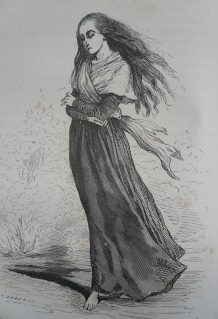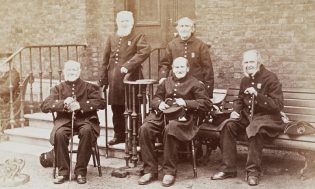
Farewell
THE HUMAN COMEDY – Honoré de Balzac XVth volume of works of Honoré de Balzac edited by widow André Houssiaux, publisher, Hebert and Co, successors, 7 rue Perronet – Paris (1874)
Philosophical studies 
FAREWELL (1830) – Study philosophical
Work dedicated TO PRINCE FREDERIC SCHWARZENBERG
Analysis of the work Published in the Revue des Deux Mondes in May 1830, Adieu is one of Balzac’s most unusual and least-known short stories. Philippe de Sucy, an officer who returned to France in 1820 after eight years’ captivity in Siberia, is reunited by chance with the Countess de Vandières, his mistress, whom he had left in dramatic circumstances just as the last of the rearguard battalions were crossing the Berezina: one of the enormous ice floes carried by the river had, in front of her, severed her husband’s head. He finds her mad, emaciated, unconscious, living like a beast, uttering inarticulate cries in an isolated castle where her uncle is nursing her back to health. He’s desperate, the disease is incurable. So he came up with a daring plan: he recreated a December day, the snow, the bridge, the burnt caissons and carriages, the stragglers and the dying, the tragic moment when the Countess had been struck by madness. The reconstruction succeeds all too well: the Countess’s eyes change, she recognizes her lover, reason returns, but the emotion is too strong, and she dies, “cadaverized”, says Balzac, “as if lightning had struck her”. Although the story had been published a year before La Peau de chagrinshe was a striking example of the destructive power of thought, which wears away “like the bayonet wears away the scabbard”, said Balzac in La Peau de chagrinBut it can also kill suddenly if it is “concentrated” in one moment and on one point. This theory of sudden death was to be illustrated a little later in Balzac’s unfinished essay Les Martyrs ignorés. The demonstrative value ofAdieu was underlined in the Revue des Deux Mondes by this epigraph (which Balzac presented as an extract from César Birotteau) which was not to be published until seven years later): “The boldest physiologists are frightened by the results of this moral phenomenon, which is, however, only a lightning strike operated internally, and, like all electrical effects, bizarre and capricious in its modes.” And Balzac would later have his spokesman Félix Davin say in theIntroduction to Etudes philosophiques: “Adieu...whose destination in the overall work no one has understood is certainly one of the most accurate and firm deductions from the theme inscribed in La Peau de chagrin… As life and love fall (on the heroine) like lightning, she doesn’t withstand the onslaught, she dies. ” Farewell is not just a demonstration. The short story was conceived in 1830 as a work for Scènes de la vie militaire. The description of the dramatic crossing of the Berezina by the last troops of the Grande Armée, documented in General de Ségur’s Mémoires, is an admirable page that should be reread more often. This impressive evocation makes us forget the extraordinary and implausible nature of the situation invented by Balzac.
The Story Countess Stéphanie de Vandières, who had followed her old husband, General de Vandières, in the Russian campaign, was saved by her childhood friend, Major Philippe de Sucy, as she crossed the Berezina. As they parted, the young woman, panic-stricken, shouted “Adieu” to her lover on the other bank. In the autumn of 1819, after six years as a prisoner of the Cossacks and eleven months back in France, Philippe de Sucy, now a colonel, was hunting in the grounds of a half-ruined former priory, the Château des Bons-Hommes, near L’Isle-Adam, when he spotted the ghostly but still strangely beautiful figure of a woman who kept repeating the word “Adieu”. A silly peasant girl, Geneviève, looks after her. The colonel thought he recognized Stéphanie de Vandières, whom he had never seen since. Monsieur de Grandville (the honest magistrate fromUne ténébreuse affaire, juge Granville) and his wife, who live nearby, give him salts to breathe. The next day, Philippe de Sucy, who had recovered his senses, instructed his friend, the Marquis d’Albon, to go to the château to check that he hadn’t made a mistake. Stéphanie’s uncle, Dr. Fanjat, who took her in, confirms Philippe’s impression that the young woman wandering in the park is indeed the mistress he has loved and sought for so long.  Here, the old uncle begins recounting the episode of the Russian campaign during the retreat of Napoleon’s armies, and more particularly the famous passage over the Berezina. Philippe de Sucy, to whom his friend d’Albon has confirmed the young woman’s identity, discovers to his horror that Stéphanie’s behavior resembles that of an animal. He tries to convince Dr. Fanjat to try a treatment on the young woman. He’s convinced that an emotional shock can bring him back to his senses, but the doctor doesn’t agree, so he tries it out. After several unsuccessful attempts, he decided to re-enact for Stephanie the scene of their tragic separation on the Beresina. Stephanie’s memory suddenly comes back, but the return to reality is too strong a sensation for the young woman, and she dies. “Life and death fall on her like lightning, but she cannot withstand the onslaught. Ten years later, the colonel, now a general, “abandoned by God”, commits suicide.
Here, the old uncle begins recounting the episode of the Russian campaign during the retreat of Napoleon’s armies, and more particularly the famous passage over the Berezina. Philippe de Sucy, to whom his friend d’Albon has confirmed the young woman’s identity, discovers to his horror that Stéphanie’s behavior resembles that of an animal. He tries to convince Dr. Fanjat to try a treatment on the young woman. He’s convinced that an emotional shock can bring him back to his senses, but the doctor doesn’t agree, so he tries it out. After several unsuccessful attempts, he decided to re-enact for Stephanie the scene of their tragic separation on the Beresina. Stephanie’s memory suddenly comes back, but the return to reality is too strong a sensation for the young woman, and she dies. “Life and death fall on her like lightning, but she cannot withstand the onslaught. Ten years later, the colonel, now a general, “abandoned by God”, commits suicide.

Emile de Girardin

Veterans of the Empire
The text of Adieu was pre-published in the weekly magazine La Mode . Emile de Girardin (1802-1881) was the grandson of Marquis René-Louis de Girardin (1735-1808), maréchal de camp. Founder of the daily La Presse, Emile de Girardin brought out the first serial novels, which he invented in partnership with his rival Armand Dutacq, director of Le Siècle. Balzac, in particular, had his novels published in the press, in part from 1831 onwards, before publishing them in volume form.
The characters General, Baron Philippe de Sucy: soldier born in 1789, died in 1830. Comtesse de Vandières: Stéphanie de Vandière, wife of the Count General de Vandière, who died in 1812. She died of insanity in 1820. Fanjat: Uncle of Mme de Vandières.
1) Source analysis: Preface from the 23rd volume of La Comédie Humaine, published by France Loisirs in 1987, based on the full text published under the auspices of the Société des Amis d’Honoré de Balzac, 45, rue de l’Abbé-Grégoire – 75006 Paris.
2) Source story: Wikipedia, the universal encyclopedia.
3) Character genealogy source: Félicien Marceau: “Balzac et son monde” (Gallimard).
No Comments